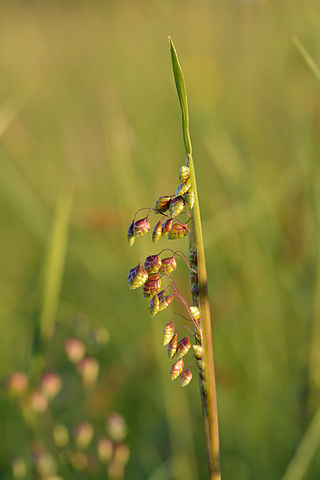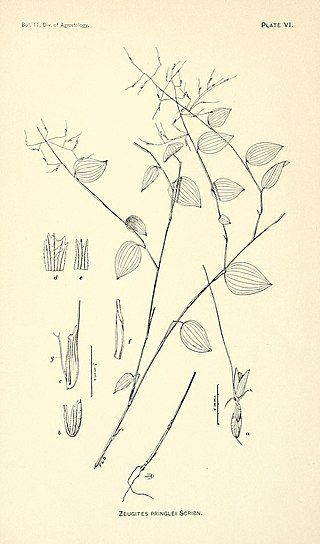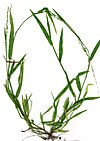
The Pooideae are the largest subfamily of the grass family Poaceae, with about 4,000 species in 15 tribes and roughly 200 genera. They include some major cereals such as wheat, barley, oat, rye and many lawn and pasture grasses. They are often referred to as cool-season grasses, because they are distributed in temperate climates. All of them use the C3 photosynthetic pathway.

Chloridoideae is one of the largest subfamilies of grasses, with roughly 150 genera and 1,600 species, mainly found in arid tropical or subtropical grasslands. Within the PACMAD clade, their sister group is the Danthonioideae. The subfamily includes widespread weeds such as Bermuda grass or goosegrass, but also millet species grown in some tropical regions, namely finger millet and teff.

Panicoideae is the second-largest subfamily of the grasses with over 3,500 species, mainly distributed in warm temperate and tropical regions. It comprises some important agricultural crops, including sugarcane, maize, sorghum, and switchgrass.

The Arundinoideae are a subfamily of the true grass family Poaceae with around 40 species, including giant reed and common reed. Unlike many other members of the PACMAD clade of grasses, the Arundinoideae all use C3 photosynthesis. Their sister group is the subfamily Micrairoideae.

The Puelioideae is a subfamily of the true grass family Poaceae with two genera, Guaduella and Puelia, each in its own tribe. Its members grow in the understory of rainforests.

Anomochlooideae is a subfamily of the true grass family Poaceae. It is sister to all the other grasses. It includes perennial herbs that grow on the shaded floor of forests in the Neotropics. There are two genera, Anomochloa and Streptochaeta, each in its own tribe.

Danthonioideae is a mainly southern hemisphere subfamily of grasses, containing the single tribe Danthonieae and one unplaced genus, with altogether roughly 300 species. It includes herbaceous to partially woody perennial or annual (less common) grasses that grow in open grasslands, shrublands, and woodlands. It belongs to the PACMAD clade of grasses, but unlike some other lineages in that clade, grasses in the Danthonioideae exclusively use the C3 photosynthetic pathway. Its sister group is the subfamily Chloridoideae.

The PACMAD clade (previously PACCMAD, PACCAD, or PACC) is one of two major lineages (or clades) of the true grasses (Poaceae), regrouping six subfamilies and about 5700 species, more than half of all true grasses. Its sister group is the BOP clade. The PACMAD lineage is the only group within the grasses in which the C4 photosynthesis pathway has evolved; studies have shown that this happened independently multiple times.

Paniceae is a large tribe of the subfamily Panicoideae in the grasses (Poaceae), the only in the monotypic supertribe Panicodae. It includes roughly 1,500 species in 84 genera, primarily found in tropical and subtropical regions of the world. Paniceae includes species using either of the C4 and C3 photosynthetic pathways, as well as presumably intermediate species. Most of the millets are members of tribe Paniceae.
Phaenospermatae is a tribe of grasses, subfamily Pooideae, containing a single genus, Phaenosperma. The tribe previously included several other genera, which are now placed in a separate tribe, Duthieeae.
Brylkinieae is a tribe of grasses, containing a single genus, Brylkinia. It used to be placed in tribe Meliceae, and had previously included a second genus, Koordersiochloa.
Centropodieae is a tribe of grasses containing only two genera. It is the earliest-branching lineage in the subfamily Chloridoideae and contains its only genus with C3 species, Ellisochloa, while all other species in the tribe and subfamily use the C4 photosynthetic pathway.

Zoysieae is a tribe of grasses in subfamily Chloridoideae, with around 250 species in four genera. All species use the C4 photosynthetic pathway.

Eriachneae is a tribe of grasses in subfamily Micrairoideae, with 50 species in two genera. Species in the tribe use the C4 photosynthetic pathway and are distributed mainly in Australasia, reaching into Asia and Micronesia.

Isachneae is a tribe of tropical and subtropical grasses in subfamily Micrairoideae, with around 120 species in six genera.

Arundinelleae is a tribe of grasses with roughly 90 species in three genera, mainly distributed in tropical and subtropical areas. The tribe's sister group are the Andropogoneae, with which they are classified in supertribe Andropogonodae. All species in this tribe use C4 carbon fixation.

Paspaleae is a tribe of the Panicoideae subfamily in the grasses (Poaceae), native mainly to the tropical and subtropical Americas but with a number of species introduced to other regions. It includes roughly 680 species in 39 genera. Species in this tribe use either of the C3 or C4 photosynthetic pathways.
Steyermarkochloeae is a tribe of the Panicoideae subfamily in the grasses (Poaceae), native to tropical South America. There are only two species in two genera, Arundoclaytonia and Steyermarkochloa. The tribe probably belongs to a basal lineage within the subfamily. Species in this tribe use the C3 photosynthetic pathway.

Tristachyideae is a tribe of the Panicoideae subfamily in the grasses (Poaceae), native to tropical and subtropical regions of Africa, Asia, and South America. There are around 70 species in eight genera. The tribe belongs to a basal lineage within the subfamily, and its genera were previously placed in tribes Arundinelleae or Paniceae, subfamily Arundinoideae, or the now-obsolete subfamily Centothecoideae. Species in this tribe use the C4 photosynthetic pathway.

Zeugiteae is a tribe of the subfamily Panicoideae in the grasses (Poaceae), native to Africa, Asia, Australasia, South and Central America. There are 18 species in four genera. The tribe belongs to a basal lineage within the subfamily. Species in this tribe use the C3 photosynthetic pathway.

















